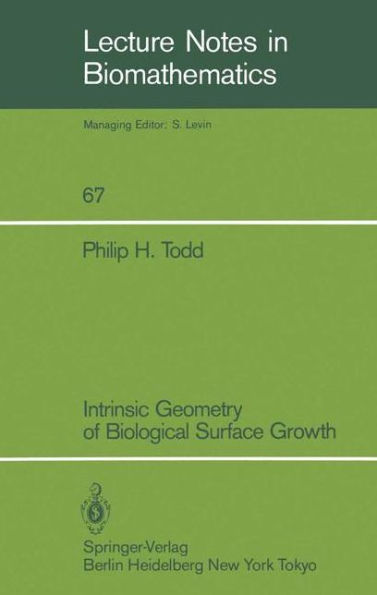Intrinsic Geometry of Biological Surface Growth
1.1 General Introduction The work which comprises this essay formed part of a multidiscip linary project investigating the folding of the developing cerebral cortex in the ferret. The project as a whole combined a study, at the histological level, of the cytoarchitectural development concom itant with folding and a mathematical study of folding viewed from the perspective of differential geometry. We here concentrate on the differential geometry of brain folding. Histological results which have some significance to the geometry of the cortex are re ferred to, but are not discussed in any depth. As with any truly multidisciplinary work, this essay has objectives which lie in each of its constituent disciplines. From a neuroana tomical point of view, the work explores the use of the surface geo metry of the developing cortex as a parameter for the underlying growth process. Geometrical parameters of particular interest and theoretical importance are surface curvatures. Our experimental portion reports the measurement of the surface curvature of the ferret brain during the early stages of folding. The use of sur face curvatures and other parameters of differential geometry in the formulation of theoretical models of cortical folding is discussed.
"1021133499"
Intrinsic Geometry of Biological Surface Growth
1.1 General Introduction The work which comprises this essay formed part of a multidiscip linary project investigating the folding of the developing cerebral cortex in the ferret. The project as a whole combined a study, at the histological level, of the cytoarchitectural development concom itant with folding and a mathematical study of folding viewed from the perspective of differential geometry. We here concentrate on the differential geometry of brain folding. Histological results which have some significance to the geometry of the cortex are re ferred to, but are not discussed in any depth. As with any truly multidisciplinary work, this essay has objectives which lie in each of its constituent disciplines. From a neuroana tomical point of view, the work explores the use of the surface geo metry of the developing cortex as a parameter for the underlying growth process. Geometrical parameters of particular interest and theoretical importance are surface curvatures. Our experimental portion reports the measurement of the surface curvature of the ferret brain during the early stages of folding. The use of sur face curvatures and other parameters of differential geometry in the formulation of theoretical models of cortical folding is discussed.
54.99
In Stock
5
1

Intrinsic Geometry of Biological Surface Growth
132
Intrinsic Geometry of Biological Surface Growth
132Paperback
$54.99
54.99
In Stock

Product Details
| ISBN-13: | 9783540164821 |
|---|---|
| Publisher: | Springer Berlin Heidelberg |
| Publication date: | 06/19/1986 |
| Series: | Lecture Notes in Biomathematics , #67 |
| Pages: | 132 |
| Product dimensions: | 6.69(w) x 9.61(h) x 0.01(d) |
From the B&N Reads Blog
